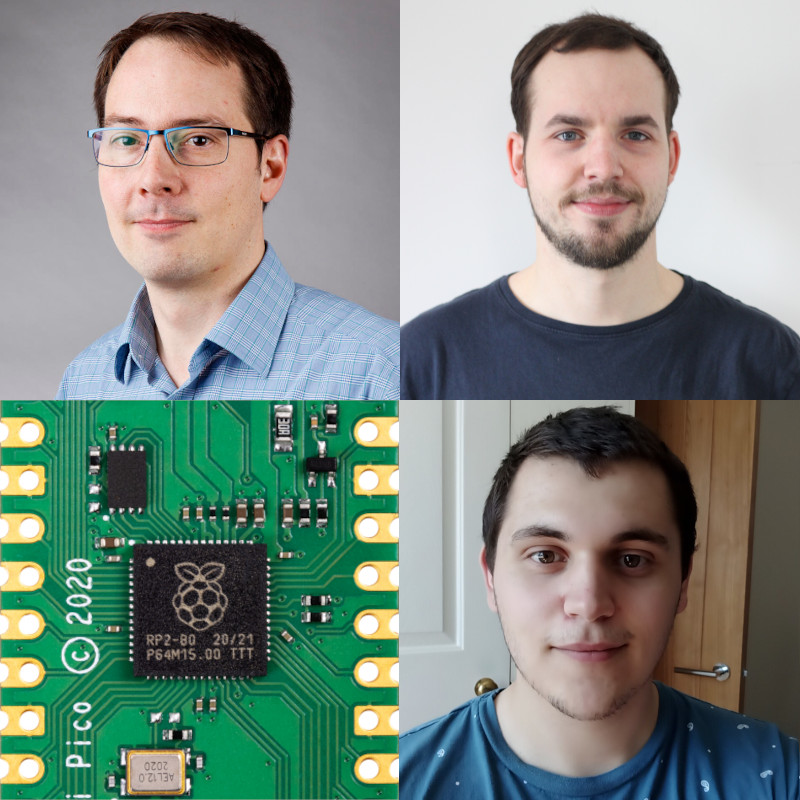Podcast: Play in new window | Download
Subscribe: Apple Podcasts | RSS
Welcome James Adams, Liam Fraser and Luke Wren of Raspberry Pi Trading!
- Raspberry Pi Trading vs Raspberry Pi Foundation
- The RP2040 is a new custom chip that Raspberry Pi released and is integrated on the Pico dev board
- 2016 start of RP2040
- Why the Pico form factor? Driver was cost (common answer throughout this interview)
- DIP form factor is interesting
- Two layer board to keep costs down
- PIO started in 2017. The idea has been around since the 60s though.
- Like a processor but very stripped down. The main thing is that it’s very deterministic.
- Demos online like driving a VGA monitor (and a demo on how to do it yourself)
- Limits are tight timing
- The RP2040 documentation and getting started guide (datasheet)
- It’s extra easy to get started using MicroPython
- Liam doing chip architecture work now, with new hardware experience in it
- Being able to push and pull across the documentation
- Raspberry Pi Trading has a flat structure so the engineers float across different projects.
- They always maintain a super low cost focus. How does that affect things internally?
- Building out test systems and automation at the factories
- Cost engineering
- Pushing cost savings back into silicon
- Volume discounts
- No reset button (because of cost)
- SWD is via a few wires (because of cost)
- Using another Pico as a programmer
- Benchmarks:
- .93 DMIPS
- Two core
- Symmetric cores for processing
- Comparing 2 M0+ vs M4
- Using 2nd core as debugger for first core (a forthcoming software project)
- To answer Dave’s question about the RP2040 being a microcontroller vs microprocessor in episode 528, it’s a “flashless microntroller”
- The flash is external (because of cost). They can create 20,000 die per wafer on 40 nm (!?!)
- The prototype of the Pico/RP2040 devices had flash, but they decided it was better to trade out for SRAM.
- The Pico team is 3 or 4 people mostly, with many more working on the Linux side of the house.
- RP2040 SDK
- Chris asks if the RP2040 will be used as co-processing on the RPi5, but it’s unlikely (because of cost).
- What about future chip development?
- Will they design big silicon like for future versions of the Raspberry Pi? Probably not (because of cost)
- RISC V? Why didn’t the use it here?
- During the time of the design freeze, the M0+ was the best fit, because it was low cycles per instruction and you can push the M0+ to higher clock rates.
- Interested in buying RP2040 to integrate on your projects? Probably Q2 availability. It’s tough to get your hands on Pico boards right now, as well, but you can sign up to be notified on different distributor sites.
- The boards come on tape and reel (because of cost) and because they expect some people to integrate these directly into future projects using the castellated edges.
- What are people missing about the boards?
- USB host should be possible soon
- Demos using USB ethernet
- PIO
- Interpolator
- Super Mario Kart
- RPi Pico’s PIO vs the BBB PRU
- Is the RP2040 Low power?
- It was design on the 40 nm LP process.
- Dormant / coma modes
- Stops all of the clocks running
- GPIO edge wakes it back up
- Memory powerdowns
- Dynamic power is pretty good, as that’s what they optimized for
- Static power is not as good
- CM4
- Genesis of the compute module
- James designed RPi4
- Temp ranges were targeted to work in harsher environments than the RPi4 would expect to see for commercial settings.
- On the CM4 they swapped out ethernet phy
- There is a compliance program for CM4 (Roger Thornton), so you can get your device tested using the same compliance house
- The cost basis was not as we speculated in episode 528.
- Why the dual micro HDMI on the RPi4? Because they expect some people to be using it like a computer.
- The PI 400 is a keyboard based computer.
- Chip choice on the Pi
- 2835 chip on the original
- James used to work for Broadcom as well as Eben Upton (on TAH 97!)
- RPi4 is 2711 on 28 nm
- 2835 was a co-processor for phones
- Why are there reduced schematics for the RPi4?
- How you can help
- Pull requests to SDK
- Contribute to Rust support
- Got to blinky in a couple days with the chip
- They are looking at FreeRTOS support in the future
- Follow everyone on Twitter: James, Liam, and Luke


https://github.com/Wiz-IO/wizio-pico